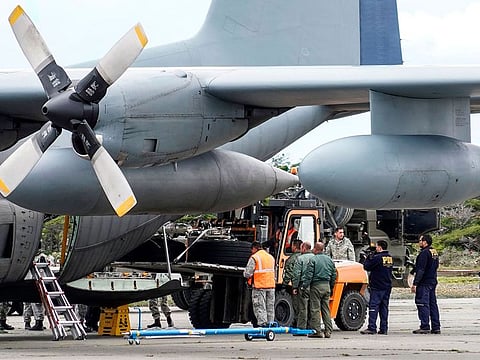Crashed Chile plane had emergency in 2016: Air Force
Authorities say they have not ruled out anything as to the cause of the crash

Punta Arenas, Chile: The Chilean Hercules C-130 plane that crashed on its way to Antarctica, killing all 38 people on board, suffered an emergency three years ago on the same route, the Air Force said Saturday.
Following the plane's disappearance Monday after taking off from the southern city of Punta Arenas, local media broadcast a video showing emergency equipment, firefighters and ambulances waiting on the runway of the city's airport in April 2016.
In a statement, the Chilean Air Force said the plane shown in the footage is the same one that crashed during a crossing of the Drake Passage connecting the Atlantic and Pacific, en route to a Chilean airbase.
As it approached the Antarctica base in 2016 "the crew realised that the left main gear of the aircraft did not travel to the down position and secure when activating the landing gear," the statement said.
The pilot decided to turn back to Punta Arenas, using an alternate method to lower the landing gear and touching down uneventfully, the statement added.
The Air Force has previously said the crashed plane's maintenance record was in order, but that it would investigate a WhatsApp audio message sent by a passenger to relatives that allegedly said the plane was having electrical problems.
Authorities say they have not ruled out anything as to the cause of Monday's crash, which killed all 21 passengers and 17 crew aboard.
Identification
Debris from the plane was located in a 12 square mile (30 square kilometer) area of the Drake Passage, a storm-tossed body of water south of Cape Horn.
On Friday, victims' remains were turned over to a coroner for identification.
The search and recovery effort continues with 23 aircraft and 10 vessels from the military, although it is restricted due to poor weather, said General Cristian Pizarro, who heads the operation.
Conditions will improve from Monday, allowing the search to continue normally, he said.
For the family of Air Force non-commissioned officer Santiago Velasquez, all they want is to get his body back, his brother Jose said.
Only then will they be able "to mourn and try to endure this life without him," Jose Velasquez said.
After 35 years of service, his brother was nearing retirement and fulfilling one of his big dreams: to fly to Antarctica.
Sign up for the Daily Briefing
Get the latest news and updates straight to your inbox


